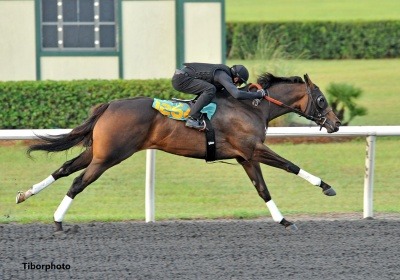
Ocala Breeders’ Sale / Photo Credit: Tibor & Judit Photography
The last time I looked at two-year-olds-in-training sales, the market had virtually collapsed, in the shadow of a looming pandemic and a stock market crash. At the Ocala Breeders Sales Co.’s March sale – the only one held so far this year – both average and median price dropped more than a third from last year, and more than half the horses listed in the catalog went home unsold. After a decade of steadily rising prices – last year some 2,200 juveniles were sold at auction for an average price of more than $94,000 – the game of musical chairs had stopped, and only a lucky few had somewhere to sit.
Since then, the coronavirus has caused the cancellation of the marquee Fasig-Tipton Gulfstream sale, as well as the high-level Keeneland 2YO sale. Other fixtures on the calendar, including the Fasig-Tipton Timonium sale and the OBS April and June sales, have been pushed back.
But now, ready or not, most states are reopening their economies, and the sales are back. OBS will offer its April catalogue from June 9-12, fattened with about half the horses that would have been through the ring at the aborted Gulfstream sale. Fasig-Tipton has rescheduled its Timonium sale, also with a bevy of Gulfstream sale refugees, for June 29-30, and the OBS June sale, usually the last chance for sellers to find a home for their juveniles, will now be held July 14-17, just before the annual yearling sales season begins.
It’s hard to predict how the market will respond. There are definitely some major negatives. Racing, albeit without fans, has pretty much rebounded from the closings in March and April, but total nationwide betting handle, all of it by phone or online, is just about what it was on corresponding days last year. That’s a discouraging fact, given that all other sports betting and casino gambling has been shut down, leaving potential gamblers nowhere else to go. Even in the absence of other sports, and of betting on those sports, racing seems to have made few new fans. And, from a horseman’s perspective, purses are down at all the major tracks that are restarting racing, reflecting the loss of slot revenue and on-track handle. The stock market has made back some, though by no means all, of its pandemic losses, but market uncertainty may still deter some big spenders.
With a truncated two-year-old racing season, with no particular reason for optimism about racing’s long-term future, and with uncertainty caused by the coronavirus by no means abating, it’s hard for sellers and the auction companies to be optimistic about this year’s remaining sales. Most consignors are probably not so much looking for the home run that will buy them a new yacht, but rather just hoping to get enough of their working capital back so they can return to the yearling auctions this summer and fall and stock up, at least to some degree, for next year.
There are, it’s true, some reasons for at least mild excitement. The breeze show for the June OBS sale is already underway, with consignors pushing their two-year-olds to run a furlong in 10 seconds flat or faster, and a quarter in 21, even though that’s something the horses will never have to do again. And OBS has tried to make it easier, both for potential buyers who are reluctant to attend in person, by permitting online bidding, and for consignors, by waiving its commission on horses that fail to reach their reserve on the auction ring. Fasig-Tipton has taken even greater steps to accommodate those who don’t want to attend in person, putting the x-rays of sales horses online for prospective buyers and their vets.
There are some interesting new sires that will be represented at the sales. Two Kentucky Derby winners, California Chrome and Nyquist, have their first juveniles ready this year, as do Grade 1 winners Frosted and Runhappy, whose yearlings sold last year for averages of $160,000 and $200,000 respectively. But will two-year-old buyers pay the same kind of premium that pinhookers were offering for those horses as yearlings last year?
When the OBS sale results are in, at the end of next week, they’ll require some careful analysis. For one thing, those refugees from the F-T Gulfstream sale will undoubtedly skew the figures higher than they otherwise would have been. Even on the first days of the OBS sale breeze show, four of the seven horses recording bullet works (including a ridiculous 9.4 seconds for an eighth and 20.1 for a quarter) were supplemental entries, added to the OBS catalog after the Gulfstream sale had been cancelled.
The best approach to analyzing next week’s sale would be to divide the results into two categories, one for the horses originally catalogued for the spring sale and the other for the supplemental nominations. Both those categories, I suspect, will continue or even extend the trend of the OBS March sale, with high numbers of unsold horses and declining average and median prices. The silver lining? For those blue-collar owners and trainers who have managed to stay in the game, there will be a lot of two-year-olds on offer for not much money that could well turn out to be decent race horses.



